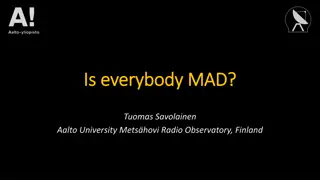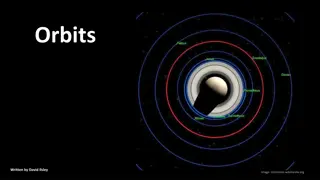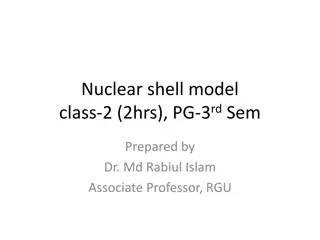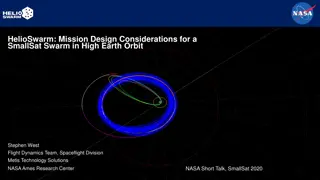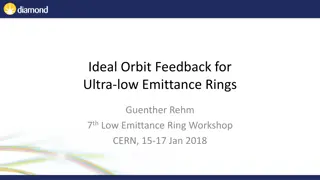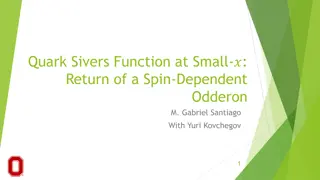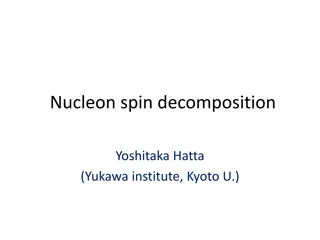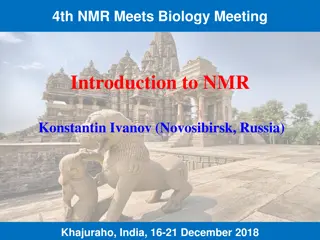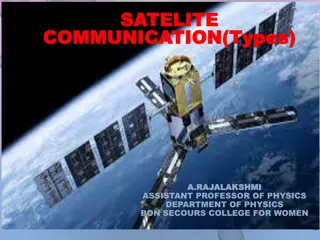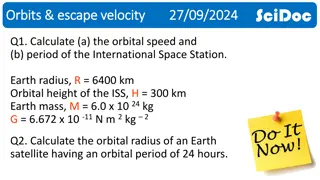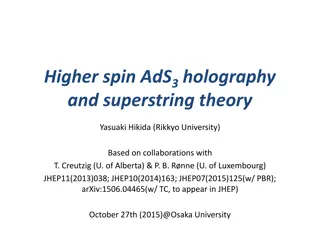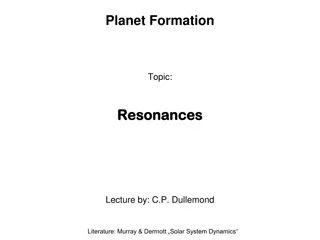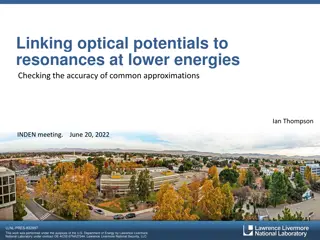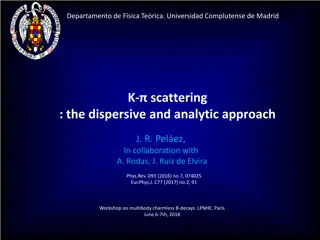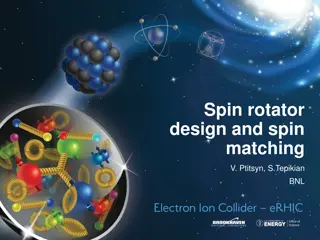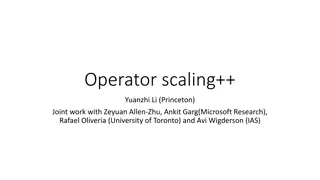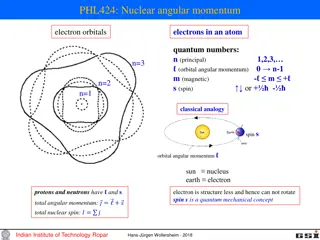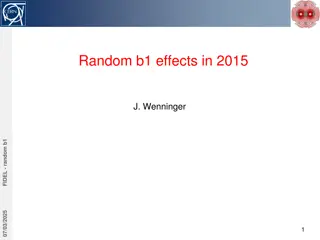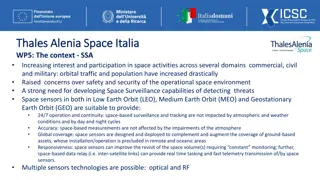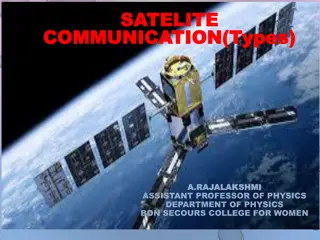AGN Jet Production Efficiency: Insights from Spin and Magnetic Flux
A fundamental question in astrophysics is how efficiently active galactic nuclei (AGN) produce jets. Black hole spin and magnetic flux play crucial roles in determining the jet production efficiency. High-spin values and large magnetic flux threading are essential for generating high-efficiency jets
2 views • 22 slides
Atomic Configurations and Term Symbols
The energy of atomic configurations is determined by electrostatic attraction between electrons and the nucleus, electron-electron repulsion, spin-orbit coupling, and spin-spin interactions. Term symbols in electronic spectroscopy specify atomic states using quantum numbers. Hund's rule and the Paul
13 views • 12 slides
Orbits and Gravity in Space
Explore the concept of orbits and gravity in space by following the trajectory of a satellite above Earth. Learn how gravity keeps the satellite in a perpetual state of orbit, moving at a constant speed parallel to the ground due to the Earth's round shape. Discover how varying speeds affect orbit s
2 views • 34 slides
Theoretical Derivation and Application of Nuclear Shell Model in Quantum Physics
The nuclear shell model, a fundamental concept in quantum physics, is explained in detail using Schrodinger wave equations and spherical coordinates. The model describes the behavior of nucleons in atomic nuclei based on energy values, quantum numbers, and shell closure principles. Spin-orbit intera
4 views • 14 slides
Mission Design Considerations for a SmallSat Swarm in High Earth Orbit
HelioSwarm presents a mission concept involving a propulsive ESPA hub deploying smallsat nodes in a lunar resonant orbit. The swarm design requirements focus on complex hub-relative trajectories for each node, emphasizing high-rate data crosslinks and measurement-optimized tetrahedra formation. Smal
11 views • 7 slides
Ideal Orbit Feedback for Ultra-low Emittance Rings Workshop Summary
The workshop on Ideal Orbit Feedback for Ultra-low Emittance Rings by Guenther Rehm at CERN in January 2018 covered topics such as Orbit Feedback Motivation, Bandwidth, Latency, Control Techniques, and References for further reading. The presentation highlighted the importance of precise beam positi
4 views • 27 slides
Quark Sivers Function and Spin-Dependent Odderon
Quark Sivers function, a key aspect in quantum chromodynamics, plays a role in capturing orbital angular momentum and spin-orbit coupling. Spin-dependent Odderon, an elusive three-gluon exchange, contributes to cross sections in high-energy collisions. Small-$? TMDs from polarized Wilson lines provi
1 views • 17 slides
Nucleon Spin Decomposition and Proton Spin Problem
Explore the complex realm of nucleon spin decomposition and the enigmatic proton spin problem, delving into concepts like orbital angular momentum, quarks and gluons' helicity, and longitudinal double spin asymmetry in polarized deep inelastic scattering. Learn about the spin crisis, gluon polarizat
4 views • 26 slides
Spin Magnetism in NMR: An Introduction to Angular Momentum and Magnetic Moments
Delve into the world of spin magnetism in NMR as we explore the concepts of angular momentum, magnetic moments, Stern-Gerlach experiments, and the quantization of spin. Learn about spin projections, spin relaxation, and the relationship between spin particles and external magnetic fields.
1 views • 34 slides
Ocean Surface Topography Science Team Meeting on Precise Orbit Determination
The Ocean Surface Topography Science Team Meeting delved into the precise orbit determination of the Jason-3 satellite, focusing on miscentering observations and the benefits of yaw flips. The meeting discussed previous approaches, the context of the satellite's orientation, goals for monitoring per
0 views • 12 slides
Different Types of Satellite Communication Orbits
Explore the various types of satellite communication orbits, including Geostationary Earth Orbit (GEO), Low Earth Orbit (LEO), Medium Earth Orbit (MEO), and Highly Earth Orbit (HEO). Learn about the advantages and disadvantages of each orbit in relation to satellite communication technologies.
5 views • 8 slides
Orbital Mechanics and Satellites Overview
This content provides calculations for the orbital speed and period of the International Space Station, as well as the orbital radius of an Earth satellite with a 24-hour period. It explains the concept of artificial satellites, different types of orbits such as Low Earth Orbit (LEO), Medium Earth O
2 views • 17 slides
Higher Spin AdS3 Holography and Superstring Theory
Delve into the fascinating world of higher spin gauge theory, Vasiliev theory, and their applications in AdS/CFT correspondence. Discover the complexity and tractability of higher spin states in superstring theory, as well as the concrete relations between superstrings and higher spin fields in AdS
4 views • 27 slides
Resonances in Planet Formation
Resonances play a crucial role in planetary systems, where characteristic frequencies align to produce dynamical consequences. Mean motion resonances, spin-orbit resonances, and secular resonances are key examples influencing planetary dynamics. Explore resonant angles, resonant arguments, and examp
4 views • 17 slides
Optical Potentials and Resonances at Lower Energies
Investigating the accuracy of common approximations in linking optical potentials to resonances at lower energies. The study focuses on neutron reactions with 14N as a test case, transitioning from R-matrix theory to Hauser-Feshbach models and evaluating known levels and level densities. Key topics
3 views • 22 slides
Analytic Approach to K Scattering and Light Scalar Controversy
The study of K scattering presents challenges in understanding the nature of resonances like the K0*(800) and implications for strange spectroscopy. The light scalar controversy delves into the classification of scalar mesons and the emerging picture of a light scalar nonet. Analyzing data on K scat
0 views • 32 slides
Spin rotator design and spin matching
In the world of spin rotator design and matching, understanding the intricate interplay between electron energy range and polarization control is key. Explore the innovative solutions and parameter selections that lead to achieving the largest continuous energy range. From electron spin rotators to
5 views • 22 slides
Search for Lepton Number Violation in K Decays at CERN
Investigation of Lepton Number Violation and resonances in K decays using the NA48/2 experiment at CERN. Theoretical motivations include Majorana neutrinos and search for resonances in K+ decays. Detailed outline of the experiment, detector specifications, and potential implications discussed.
0 views • 13 slides
Quark Sivers Function and Spin-Dependent Odderon: Insights from Small-?
Quark Sivers function and spin-dependent Odderon play crucial roles in understanding the three-dimensional structure of hadrons and the asymmetries observed in high-energy scattering processes. Ongoing efforts are focused on determining the small-? asymptotics of these functions and their contributi
1 views • 17 slides
Operator Scaling by Yuanzhi Li and Collaborators: Group Actions & Orbit Intersection Problems
This paper delves into the fascinating realm of operator scaling discussed by Yuanzhi Li from Princeton University in collaboration with other researchers. The focus is on group actions and problems related to orbit intersection, offering insight into graph isomorphism, complexity levels, and an eff
3 views • 60 slides
Nuclear Angular Momentum in Atoms: Quantum Numbers and Spin
Explore the quantum numbers and spin related to nuclear angular momentum in atoms, including the principles of electron orbitals, orbital angular momentum, magnetic quantum numbers, and spin concepts. Gain insights into the total angular momentum and nuclear spin in atomic structures.
0 views • 8 slides
Constructing Curved Space Orbits with Energy Curves and Gfield Systems
This paper delves into the geometric complexities of constructing the orbit of Mercury, exploring Galilean energy curves to rectify perceived irregularities in square space ellipses. Through Euclidean and analytic geometry, alongside elementary calculus, a curved space perception is introduced to ap
0 views • 13 slides
Random b1 effects in 2015
After 6 weeks of operation, the orbit and correctors at injection and in the ramp show promising control. The study focuses on the evolution of corrector kicks, snapback effects, and orbit changes in both horizontal and vertical planes. Notable observations include rapid kicks in the horizontal plan
0 views • 6 slides
Spin Model Checker and Promela Architecture
Delve into the details of Spin Model Checker and Promela system architecture, including SW coverage criteria, scheduling analysis, Spin architecture overview, and components like Tcl GUI. Discover the characteristics of Spin Promela, asynchronous execution, non-determinism, process communication, an
0 views • 25 slides
Enhancing Space Surveillance Capabilities for Safety and Security
In response to the growing concerns over safety and security in the operational space environment, Thales Alenia Space Italia is focusing on developing space surveillance capabilities for threat detection. This involves utilizing space sensors in Low Earth Orbit, Medium Earth Orbit, and Geostationar
1 views • 4 slides
Spin Polarization and Depolarization in Particle Accelerators
This simulation explores the generation and transmission of polarized beams in the CEPC accelerator, focusing on maintaining beam polarization in the booster and collider regions. It delves into spin motion in a synchrotron, discussing the preservation of polarization in perfect and real ring scenar
3 views • 13 slides
Types of Satellite Communication: GEO, LEO, MEO, HEO Explained
Explore the different types of satellite communication including Geostationary Earth Orbit (GEO), Low Earth Orbit (LEO), Medium Earth Orbit (MEO), and Highly Elliptical Orbit (HEO). Learn about the advantages and disadvantages of each orbit for various communication purposes.
2 views • 8 slides
Nuclear Resonances and Timescales
Exploring the relevance of lightly bound and unbound ground state resonances in NSDD 2024, along with discussions on controversies, articles, and nuclear timescales defining the existence of a nucleus. The content delves into definitions, limitations, and considerations regarding radioactive element
2 views • 11 slides
Spin Glasses: Experimental Signatures and Outcomes
Explore the intriguing world of spin glasses, including aging effects, memory phenomena, and correlation lengths of spin-glass orders. Discover the theory behind spin glasses, their magnetic properties, and the cluster-glass distinction in this comprehensive study.
0 views • 20 slides
Advances in Free Spin Precession Method by Ivan Koop
Explore the Free Spin Precession Method (FSP) by Ivan Koop, where spins of polarized particles are deflected using an RF flipper to analyze spin rotation and harmonics. Discover the application of RF-Flipper for coherent rotation of spins and the algorithm to calculate effective harmonic values for
1 views • 24 slides
Orbit Correction Challenges in eRHIC FFAG Lattice
Explore the unique challenges in correcting orbits within the eRHIC FFAG design, where multiple beams of varying energies require specialized correction strategies for optimal performance and beam alignment. Learn about the orbit correction strategy and the impact of lattice errors on orbit distorti
0 views • 22 slides
How to Become a Spin-Off of Politecnico di Milano
Learn the requirements and procedure to establish a spin-off company associated with Politecnico di Milano, including staff promotion criteria, intellectual property handling, product development, innovation focus, reputation considerations, and competition limitations. Understand the necessary docu
0 views • 7 slides
Intrinsic Spin Effects and Hubbard Model in Solid State Physics Lecture
Explore the concepts of intrinsic spin effects and the Hubbard model in solid state physics through an exact analysis of a 2-site system and periodic one-dimensional systems. The lecture covers the intrinsic spin of electrons, the Hubbard Hamiltonian, possible site configurations, and the Hubbard mo
3 views • 30 slides
Orbit Correction Analysis and Optimization Schemes by Arman Ballado
Explore the analysis and optimization of orbit correction schemes in a project by Arman Ballado, focusing on evaluating and optimizing the performance of Beam Position Monitors (BPMs) and Corrector Magnets (CMs) in a model of the Cornell ERL. Various aspects such as Generalized Response Matrix, Sing
6 views • 19 slides
Understanding Earth's Seasons through Its Orbit
Explore the reason behind opposite seasons in different hemispheres by investigating Earth's orbit around the Sun and the tilt of its axis. Engage in hands-on activities to simulate the changing seasons and understand the distribution of sunlight across different positions in Earth's orbit.
0 views • 12 slides
Understanding Hadron Structures and Resonances in Dense Matter
Explore the role of resonances in finite density matter with various structures, focusing on chiral baryons and their implications for mass generation. Delve into the mixing of compact and extended structures in hadron formation, with a special emphasis on meson and nucleon resonances. Discover the
2 views • 17 slides
Vector Meson-Baryon Interaction: Dynamically Generated Resonances
Explore the intricacies of the vector meson-baryon interaction and the dynamically generated resonances in the sector with S=0. Uncover the underlying theories and approaches to understanding this topic through local gauge symmetry and interaction potentials.
3 views • 42 slides
Driving Industrial Strategy Forward: Key Pillars, Priorities, and Resonances
Explore the pillars, priorities, and resonances of the Industrial Strategy, including investing in science and innovation, developing skills, and upgrading infrastructure. Discover how these key elements align with LEP goals and regional growth strategies, emphasizing the importance of talent develo
0 views • 22 slides
Hyperon Resonances Study via Coupled-Channels Analysis
Explore the in-depth analysis of S = -1 hyperon resonances through coupled-channels investigation of K-p and K-d reactions. Dive into the current understanding, challenges, and advancements in Y* spectroscopy using Dynamical Coupled-Channels (DCC) approach. Uncover the complexities of Y* resonances
3 views • 25 slides
Remote Sensing Platforms and Sensors Overview
Explore the various orbits of remote sensing satellites and their advantages, including Low Earth Orbit, Sun Synchronous Orbit, and High Earth Orbit. Understand the different types of orbits and their applications in remote sensing technology. Discover how satellites pass over the Earth's surface, p
0 views • 42 slides
